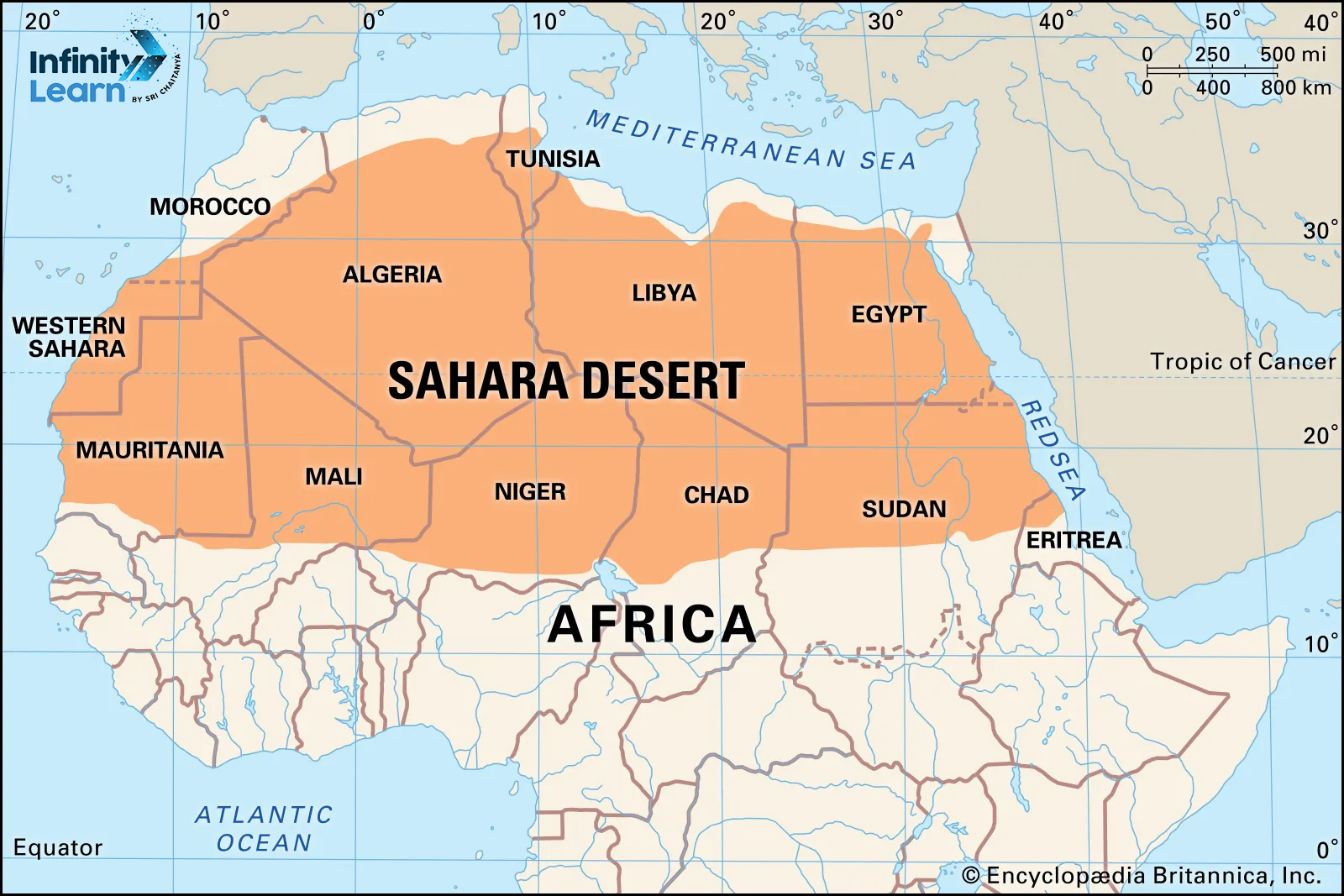
Courses

By Shailendra Singh
|
Updated on 3 Jan 2025, 17:38 IST
Discover the amazing beauty of the Sahara Desert, a vast and mysterious expanse in North Africa. This blog goes into depth about the fascinating history, geographical features, and unique cultural tapestry woven by the countries that share this iconic desert’s border.
Discover the secrets of the Sahara as we travel through its varied landscapes, from mesmerizing sand dunes to rocky plateaus, and uncover ancient rock art that tells stories of a time when the Sahara was a much wetter and thriving region.
Join us on a journey through the sands of time as we investigate the Sahara’s geographic location and the historical treasures hidden beneath its arid surface. This blog promises to be your gateway to the extraordinary realm of the Sahara Desert, whether you are a history enthusiast, a geography buff, or simply curious about the wonders of our world.
The Sahara is a desert spanning North Africa, with an area of 9,200,000 square kilometers. It is the largest hot desert in the world and the third-largest desert in the world. The Sahara Desert is only smaller than the deserts of Antarctica and the Arctic.
The name Sahara is derived from the Arabic word for desert in its feminine irregular form. The Sahara Desert is known for its extreme climatic conditions, with scorching daytime temperatures that can exceed 50 degrees Celcius and significantly chilly nights. Rainfall is scarce, and the region is considered hyper-arid, receiving very little precipitation.
The Sahara is so large and bright that it could be detected as a surface feature of Earth by other stars using current technology. The Sahara is mainly a rocky stone plateau; ergs form only a minor part, but many of the sand dunes are over 590 feet high.
People have lived on the desert’s edge for thousands of years, since the end of the last glacial period. Engraved and painted rock art was created in the Central Sahara possibly as early as 10,000 years ago, spanning the Bubaline Period, Kel Essuf Period, Round Head Period, Pastoral Period, Caballine Period, and Cameline Period.

The desert covers much of North Africa, excluding the fertile regions on the Mediterranean Sea coast, the Atlas Mountains of the Maghreb, the Nile Valley in Egypt, and the Sudan.
It stretches from the Red Sea in the east and the Mediterranean in the north to the Atlantic Ocean in the west, where the landscape gradually changes from deserts to coastal plains. To the south, it is bounded by the Sahel, a belt of semi-arid tropical savanna around the Niger River valley and the Sudan region of sub-Saharan Africa.
The Sahara can be divided into several regions, including the western Sahara, the central Ahaggar Mountains, the Tibesti Mountains, the Air Mountains, the Tenere Desert, and the Libyan Desert.


The Sahara Desert is located in northern Africa and covers over 3,500,000 square miles (9,000,000 square kilometers), or approximately 10% of the continent. The Red Sea borders it on the east, and it stretches west to the Atlantic Ocean.
Algeria, Chad, Egypt, Libya, Mauritania, Morocco, Niger, Western Sahara, Sudan, and Tunisia are among the countries that make up the vast desert.
The Atlantic Coastal Desert ecoregion spans 39,900 square kilometers along the Atlantic coast in the western Sahara Desert. The North Saharan steppe and woodlands ecoregion extends 1,675,300 square kilometers along the northern edge of the Sahara Desert.
The Sahara Desert is located in North Africa, spanning countries such as Morocco, Algeria, Chad, Egypt, Libya, Mali, Mauritania, Niger, Western Sahara, Sudan, and Tunisia. It is the largest hot desert in the world, covering an area of 3.6 million square miles. The desert is known for its sand dunes, which can reach up to 180 meters in height
The real name of the Sahara Desert is Al-Sahra, al-Kubra, or the Great Desert in Arabic. The name is derived from the Arabic word Sahra, which means desert.
Yes, the Sahara Desert is famous for its size, geographical features, and historical significance. It is the world's largest hot desert and covers nearly all of northern Africa. The desert is characterized by its arid climate, sand dunes, and rocky landscapes, which make it a difficult environment for sustaining life.